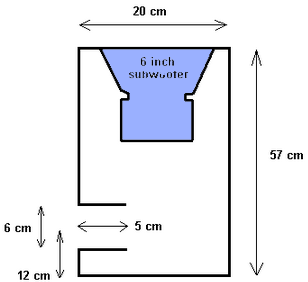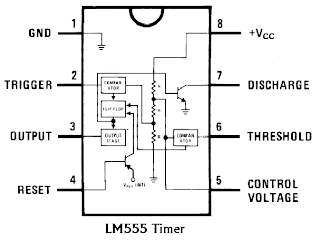Simple Circuit 12V to 120V DC DC Converter
When pin 1 is high transistor Q1 conducts and current flows through the upper half of T1 primary winding. When pin 2 is the transistor Q2 conducts and high current flows through the lower half of the primary coil T1. As a result of a voltage of 120 V AC are induced in the secondary of T1. This voltage is rectified with bridge D1 to provide a 120V DC output. Capacitor C2 is the DC input filter, while C3, C4 are the output filters.
Notes.
- The circuit can be assembled on a vero board.
- Q1 and Q2 require heat sink.
- Output power of this dc dc converter is around 100 watts.
- IC1 and IC2 are to be mounted on holders.
- An optional 5A fuse can be added in series to the 12V supply line.
- T1 can be a 9-0-9V /250V/3A mains transformer.
- If 3A bridge is not available make one using 1N5408 diodes.
- Out of the two Flip-Flops inside CD4013 only one is used here.
- Output of IC1 must be set to 100Hz by adjusting preset R1
12 Volt Charger Circuit with LM350

Vertical IC PIN OUT DATA
Vcc to pump-up can be traced through the diode PUM-up and pump up Elco Capacitor
VfB = or to Vin2
= Gnd or Vcc (-)
Vertical IC PIN-OUT DATA
AN5521 Vin = 4, Vout = 2, Vcc = 7, Gnd = 1, VfB =
AN5522 Vin = 7, Vout = 5, Vcc = 2, Gnd = 4, VfB = 1
AN5539 Vin = 4, Vout = 2, Vcc = 6, Gnd = 1, VfB = 5
AN15525 Vin = 7, Vout = 5, Vcc = 2, Gnd = 4, VfB = 1
LA7832 Vin = 4, Vout +2, Vcc = 6, Gnd = 1, VfB = 5
LA7835 = 2 Vin, Vout = 11, Vcc1 = 1, Vcc2 = 7,
LA7837 = 2 Vin, Vout = 12, Vcc1 = 1, Vcc2 = 8, Gnd = 11, VfB = 7
LA7838 = LA7837
LA7840 Vin = 4, Vout = 2, Vcc = 6, Gnd = 1, VfB = 5
LA7841 = LA7840
LA7845 = LA7840
LA7846 = 5 Vin, Vout = 3, Vcc = 7, Gnd = 2, VfB = 6
LA7848 Vina = 5, VinB = 6, Vout = 3, Vcc (+) = 7, Vcc (-) = 2
LA7876 Vina = 5, VinB = 6 Vcc (+) = 7, Vcc (-) = 2
STV9302 = see AN5522
STV9379 = See AN5522
TA8403 Vin = 4, Vout = 2, Vcc = 6, Vcc = 6,
TA8445 Vin = 2, Vout = 11, Vcc1 = 1 (9v), Vcc2 = 7 (26v), Gnd = 10, 50/60 =
TDA1771 Vin = 3, Vout = 1, Vcc = 9. Gnd = 5
TDA4865 Vin = 6, Vout = 5, Vcc = 1, Gnd = 4, VfB = 2
TDA8175 Vin = 7, Vout = 5, Vcc = 2, VfB = 1
TDA3653 Vin1 = 1, Vin2 = 3, Vcc1 = 9, Vcc2 = 6, Vou = 5, Gnd = 4
TDA8350 Vina = 1, VinB = 2, VoutA = 10, VoutB =, Vcc1 = 3, Vcc2 = 9, Ewin = 12, Ewout = 11
See tda8357 TDA8351 =
See TDA8357 TDA8356 =
TDA8357 Vina = 1, VinB = 2, VoutA = 7, VoutB = 4, Vcc1 = 3 (12v), Vcc2 = 6 (45V), Gnd = 5
TDA8358 Vina = 1, VinB = 2, Vcc1 = 3 (12v), Vcc2 = 9 (25V), VoutA = 4, VoutB = 10, Gnd = 6.7, Ewin = 5, Ewout = 8
TDA9302 = see LA78040
Solar tracker With AT89S52
Solar tracker With AT89S52
Timer with about 10 minutes

Basic Principles of the LC resonance circuit
LM350 12 Volt Battery Charger

Drive Stepper Motor with IC UCN5804
Drive Stepper Motor circuit UCN5804
In the series of stepper motor drivers with IC UCN5804 above to run a DC motor takes 2 inputs ie, the input signal and the input logic stepper direction of rotation. The input signal is a pulse stepper with a certain frequency where the frequency of these pulses that determines the speed of stepper motor puter. Then the input logic is a stepper motor rotating direction input logic 0 and 1 that is given to the IC UCN5804 to adjust the stepper motor rotating direction.
Voltage to frequency converters LM231 LM331
| Voltage-to-frequency converters LM231/LM331 |
- Improved performance in existing voltage-to-frequency
conversion applications
- Split or single supply operation
- Operates on single 5V supply
- Pulse output compatible with all logic forms
- Excellent temperature stability, ±50 ppm/°C max
- Low power dissipation, 15 mW typical at 5V
- Wide dynamic range, 100 dB min at 10 kHz full scale
- Wide range of full scale frequency, 1 Hz to 100 kHz
- Low cost
Characteristic NiCad Battery Charger
The point is that these NiCad battery can supply current to the electronics equipment with current 700mA for 1 hour (for 700mAh battery). So if we use these 700mAh NiCad batteries for electronic devices that draw a current of 1 A, the NiCad battery can only last for less than 1 hour. The temperature of NiCad batteries also affect battery life. If the battery is too hot the battery will quickly run out due in part generated by the battery current is converted into heat.
Characteristics NiCad Batteries :
Class A headphone amplifier
 |
| Class A headphone amplifier |
TDA 7309 Digital Audio Processor Circuit
 |
USB Battery Charger controller circuit using LM3622

TDA1308T Headphone amplifier circuit
 |
| TDA1308T Headphone amplifier circuit |
555 Timer IC Working Principle
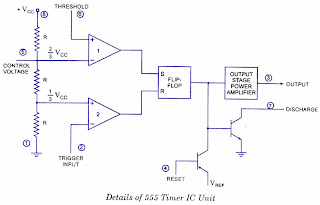 |
Block Diagram of 555 timer IC: |
11 90 hz Subwoofer Filter Using TL072 Op Amp

 11-90 hz Subwoofer Filter Using TL072 Op-Amp
11-90 hz Subwoofer Filter Using TL072 Op-AmpThe Subwoofer clarify ambit to abolish for abstracted pre amplifier to drive the low abundance complete a lot. In tone, alarm tone, accustomed Can not be done … is a accomplished abysmal low bass sounds like a bass drum, or at a cine circuitous in a low articulation if we can be heard with But to add cabinets and amps. The subwoofer ambit is canyon low abundance with in 11-90 Hz. Switching ability accumulation 12V cut out if they charge to use +-15V. I had change the Capacitor to cut out vocals per the red amphitheater mark.
Traffic Lights Circuit
Well ... if youre looking for examples of a series of simple traffic light above the range can I recommend to you. The working principle of a series of traffic light above is very easy to understand. The series of above use the output from IC up / down counter 74 190 as the producer output tercacah and then conditioned using logic gates so that the logic in accordance with the logic of the actual traffic light. Actually you can also use the IC counter ups as pencacahnya. Red lights are represented by the LED D1, D2 and yellow by green led by led D3.
LIST OF COMPONENTS:
Resistors: R1 (1 Kohm), R2, R3 and R4 (220 ohms) and VR1 (Potensio 10 K / 15 K)
Capacitors: C1 (100 UF)
Led: D1 (red), D2 (yellow) and D3 (green).
Integrated Circuit: IC1 (NE 555), IC2 (74LS190) and IC3 (74LS02)
HOW TO WORK AND ANALYSIS OF CIRCUIT LIGHT TRAFFIC:
To generate the signal used peggerak counter circuit astable circuit IC555.
R1, C1 and VR1 is a combination astable as a determinant of the speed of the clock signal to be inserted to the input counter and in the end will determine the length of time the flame of their lamps. The greater the value of the three clock cycles will stay longer and vice versa.
To obtain a combination of LEDs required only 2 bits output from the counter circuit.
Bit-3 from the output to the counter only be used as reset the enumeration.
The lamp was first lit the light yellow color, due to connect with the output Q1 of counter IC. Then followed by a red lamp that is connected to the output Q2. Then both (yellow and red) light simultaneously. The last green light will turn on its own.
The series of bit counter counts up with the sequence:
- 0 1 (light yellow light)
- 1 0 (red light)
- 1 1 (light yellow and red lights)
- 0 0 (light turned green, according to the nature of the gate NOR)
Examples of traffic light sequence apply only to one lane for traffic light circuit that uses more than one line then you can use the same circuit device and use a combination of gates as a liaison between the conditions of each lane. This means you should make a longer red light is illuminated on each other point for point which it operates. These conditions can be achieved by utilizing a combination of logic gates in a chain.
50MW Audio Amplifier circuit
Due to recent increases in bias voltage between the emitter and base decreases as a result of minimizing driving. Input impedance is 500 ohms and the voltage gain is approximately five to eight ohm speaker connected. The voltage swing around the speaker is 2 volts without distorting production and capacity is at the same time in the 50 milliwatt range. A high voltage provided as well as the addition of heat sinks in the output transistors would be a great source of more power. Circuit thirty milliamperes draw a supply of 9 volts.
LED Flasher Circuit Using 555 Timer IC

Symmetrical Power Supply LM317 337 Variable
In the application field can be mounted voltmeters at each point its output to ease in setting the output voltage level circuit Symmetrical Variable Power Supply LM317/337 this.
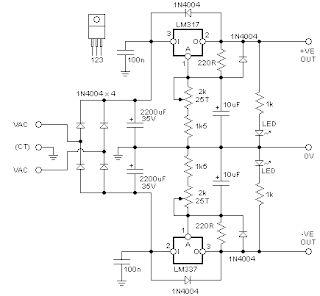
Circuit of symmetrical power supply LM317/337 variable using input source voltage of 18V AC 18V CT transformer CT. To set a positive voltage level can be done by adjusting the potentiometer 25K at the LM317 regulator and to regulate the negative voltage level carried out by adjusting the potentiometer 25K at the LM337 negative voltage regulator.
AC to DC 90 Watt Switching Adaptor
AC to DC switching adaptor circuit with best achievement ability of 90W. Switching ability accumulation is congenital application a aerial voltage ability switching regulator IC MC33374 and some added added components. The MC33374 IC is a caked aerial voltage ability switching regulators that are distinctively advised to accomplish anon from a rectified AC band source, and in flyback advocate applications.
Ramp Generator With 555 Timer IC
Charging current produced by PNP constant current source is
iC = Vcc-VE / RE
where VE = R2 / (R1 + R2) * VCC + VBE
FM Signal Tracker
Circuit FM Tracker 1.5 V [Tracking transmitter]
| FM Signal Tracker |
Series Description 1.5 Volt Tracking FM [Tracking Transmitter]
For stability, use a NPO types for C2 & C4.
Tolerance for R1 must be 1 or 2%.
Common frequency range is 87-109Mhz FM.
Email wire used in wire coil is made of hookup 22 ga, such as solid Bell phone wire.
Atmel 89S and AVR Programmer STK200


Room Noise Detector
This circuit is intended to signal through a flashing LED, more than a fixed threshold, room noise, chosen from three fixed levels, namely 50, 70 and 85 dB. Two op amps provide the necessary gain of the circuit sounds like a pick-up is a miniature electric microphone to drive the LEDs. When SW1 at the top of the circuit off. The power of the second, third and fourth circuit and set the entry threshold is 85, 70 and 50 dB. Current drawing is less than 1 mA with LED off and 12 15 mA when the LED is steady on.
Room Noise Detector Components :
R1____________10K 1/4W Resistor
R2,R3_________22K 1/4W Resistors
R4___________100K 1/4W Resistor
R5,R9,R10_____56K 1/4W Resistors
R6_____________5K6 1/4W Resistor
R7___________560R 1/4W Resistor
R8_____________2K2 1/4W Resistor
R11____________1K 1/4W Resistor
R12___________33K 1/4W Resistor
R13__________330R 1/4W Resistor
C1___________100nF 63V Polyester Capacitor
C2____________10µF 25V Electrolytic Capacitor
C3___________470µF 25V Electrolytic Capacitor
C4____________47µF 25V Electrolytic Capacitor
D1_____________5mm. Red LED
IC1__________LM358 Low Power Dual Op-amp
Q1___________BC327 45V 800mA PNP Transistor
MIC1_________Miniature electret microphone
SW1__________2 poles 4 ways rotary switch
B1___________9V PP3 Battery
Clip for PP3 Battery
PIC Volt and Amere Meter Circuits

FRIDGE DOOR ALARM CIRCUIT
Important Notes
- Delay time can be varied changing C1 and/or R3 values.
- Beeper repetition rate can be varied changing C2 and/or R4 values.
- Stand-by current drawing: 150µA.
- Place the circuit near the lamp and take it away when defrosting, to avoid circuit damage due to excessive moisture.
- Do not put this device in the freezer.
Circuit Diagram
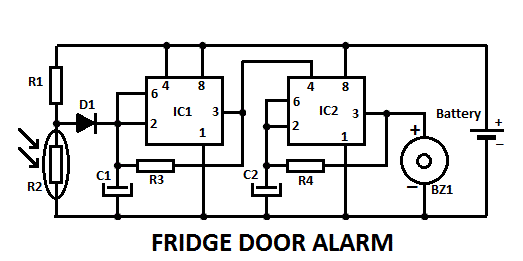
Components List
GAS LEAK DETECTOR CIRCUIT
Circuit Schematic
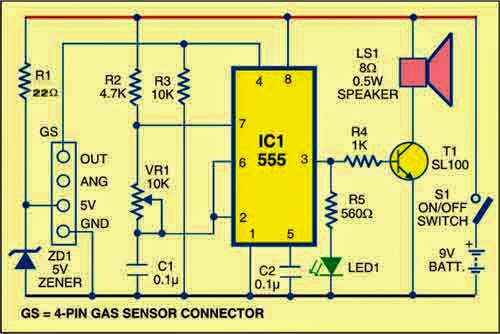
SEN1327 gas sensor pin details

6 WATT Hi Fi AUDIO AMPLIFIER USING TDA2613
Circuit Diagram of 6 Watt Amplifier using TDA2613
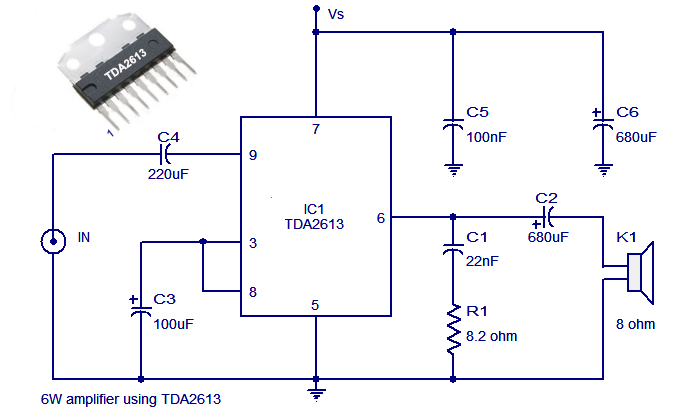
Notes
- Assemble the circuit on good quality PCB.
- Supply voltage (Vs) can be anything between 15 to 24V DC.
- Heat sink is necessary for TDA2613.
- Do not give more than 24V to TDA2613.
12v to 5v dc dc converter circuit diagram
Circuit Diagram of 12VDC to 5VDC converter:
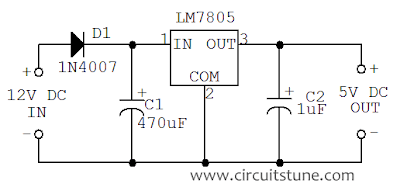 |
| Fig: 12 volt to 5 volt dc converter circuit schematic |
Heat Sink Basics
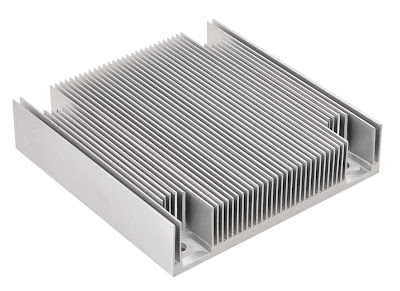 |
| Fig-1: Heat Sink (Aluminum Sheet) |
 |
| Fig-2: Heat Sink (Aluminum Sheet) |
 |
| Fig-3: Heat Sink with Transistor/IC |
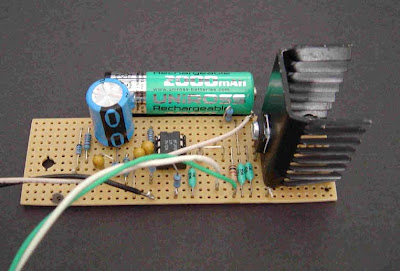 |
| Fig-4: Heat Sink with Transistor/IC |
Most of power is dissipated at the collector-base junction. This is because collector-base voltage is much greater than the base-emitter voltage, although currents through the two junctions are almost the same.
Heat sink is a direct practical means of combating the undesirable thermal effects e.g. thermal runaway. It may be noted that the ability of any heat sink to transfer heat to the surrounding depends upon its material, volume, area, shape, contact between case and sink and movement of air around the sink. Finned aluminum heat sinks yield the best heat transfer per unit cost. It should be realized that the use of heat sink alone may not be sufficient to prevent thermal runaway under all conditions. In designing a transistor circuit, consideration should also be given to the choice of (i) operating point (ii) ambient temperatures which are likely to be encountered and (iii) the type of transistor e.g. metal case transistors are more readily cooled by conduction than plastic ones. Circuits may also be designed to compensate automatically for temperature changes and thus stabilize the operation of the transistor components.
12 Volt Battery Guardian

Main features:
- Cuts power to load (eg, fridge) when battery voltage drops below a preset level.
- 10A rating.
- Low power drain.
- Chirping sound during cut-out.
- Flashing LED indication during cut-out.
- Automatically reconnects power when battery recharged.
Parts layout:
 PCB layout:
PCB layout:
Circuit diagram:


